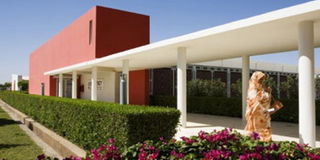Two buildings in Africa among 5 of the world's best

The Salaam Center for Cardiac Surgery in Khartoum.
What you need to know:
- In Khartoum, the Salam Centre for Cardiac Surgery impressed the judges for its welcoming architecture that “provides an exemplary prototype for the region as well as for the field”.
Two building projects in Africa have emerged among five of the world’s most compelling in terms of their architecture’s ability to grow social bonds and protect heritage.
The winners were announced at Lisbon’s Castle of São Jorge yesterday evening at a gala jointly presided over by President Aníbal Cavaco Silva of Portugal and the award scheme’s founder, the Aga Khan, who is the spiritual leader of the Ismailia Muslims.
The projects in Sudan and Morocco were picked from dozens across the globe by a team of nine eminent scholars and renowned architects together with three others in Iran, Palestine and Austria to be recipients of this year’s US$1 million Aga Khan Award for Architecture.
The winners - found to most embody architectural excellence while ensuring a positive impact on quality of life - were selected from 20 finalists.
Sudan
In Khartoum, the Salam Centre for Cardiac Surgery impressed the judges for its welcoming architecture that “provides an exemplary prototype for the region as well as for the field”.
They found that the Centre meets the high technical demands of a hospital with complex functions, including three operating theatres, while providing a number of eco-friendly solutions to common problems. Its mixed modes of ventilation and natural light enable all spaces to be homely and intimate.
In addition to solar panels and special insulation techniques, its architects reused 90 six-metre (20-foot) containers that had been discarded after being used to transport construction materials for the Centre.
Morocco
In Rabat-Salé, Morocco, the Urban Infrastructure Project linking Rabat and Salé cities to form an urban hub was born out of a new vision of large-scale regeneration, one in which improved transportation and mobility were to be priority components of the larger urban plan.
The judges found that the project combines exemplary bridge design, infrastructure improvement and urban planning. As a result, the Hassan II Bridge has become a new icon for Rabat-Salé, reinforcing a modern, progressive, twin-city identity. The judges remarked that the project was “a sophisticated and cohesive model for future infrastructure projects, especially in places of rapid urbanisation”.
The Rabat-Salé bridge inspired the judges to comment: “Architecture is a quintessentially urban activity that is identified with urbanism and urban life. In spite of their density, urban settlements often generate an experience of solitariness, a feeling of being cut off in a disintegrated world.
In a context where big bridges tend to be destructive elements within the city structure and the landscape, a bridge that touches the ground lightly and seeks to create places for pedestrian activity stands out. The bridge connects society, both metaphorically and physically, and contributes to a three-fold integration: of public design, infrastructure and landscape.”
Panel
The judging panel, known as the master jury, was chaired by Ugandan scholar Mahmood Mamdani.
Four other African building projects in Rwanda, South Africa and another two in Morocco made it to the final shortlist but were beaten to the final list of five.
Other finalists were from Afghanistan, Austria, China, India, Indonesia, Iran, Lebanon, Palestine, Sri Lanka, Syria, Thailand and Yemen.
The award scheme selects projects – from innovative mud and bamboo schools to state of the art “green” high-rises – which not only exhibit architectural excellence but also improve the overall quality of life.
It is a project of the Aga Khan Trust for Culture, whose other prominent projects in East Africa include the revitalisation of the Stone Town in Zanzibar. The Trust last year signed an agreement with the Kenya government to help rehabilitate Nairobi’s City Park.
Farrokh Derakhshani, the director of the award, said: “The Master Jury, which includes some of the most prominent architects of our time, made interesting choices this year. For example, they chose schools in Afghanistan and Syria, but they also chose a hospital in Sudan, a high rise in Bangkok and the reconstruction of a refugee camp in Lebanon.
In many ways, the choices reflect a central preoccupation of the Award: the impact of buildings and public spaces on the quality of life. Now this seems fairly mainstream, but we must remember that the Aga Khan Award has been talking about 'human scale' and 'sustainability' since 1977”.
Given in cycles of three years, the award celebrates projects that remain true to a people and their history, while at the same time delivering beauty and functionality in a sustainable manner. It recognises all types of building projects that affect today’s built environment, from modest, small-scale projects to sizable complexes.
The US$ 1 million prize, which will be divided among the five recipients, does not necessarily go to the architect. The Award also identifies municipalities, builders, clients, master craftsmen and engineers who have played important roles in the realisation of a project. The Master Jury has the discretion to apportion the prize money however it sees fit.
The award scheme was set up by the Aga Khan in 1977 to help inspire buildings that put sustainable life and promotion of a people’s culture at its core. The Aga Khan is also the principal shareholder of Nation Media Group, which publishes the Saturday Nation amongst other media outlets.




